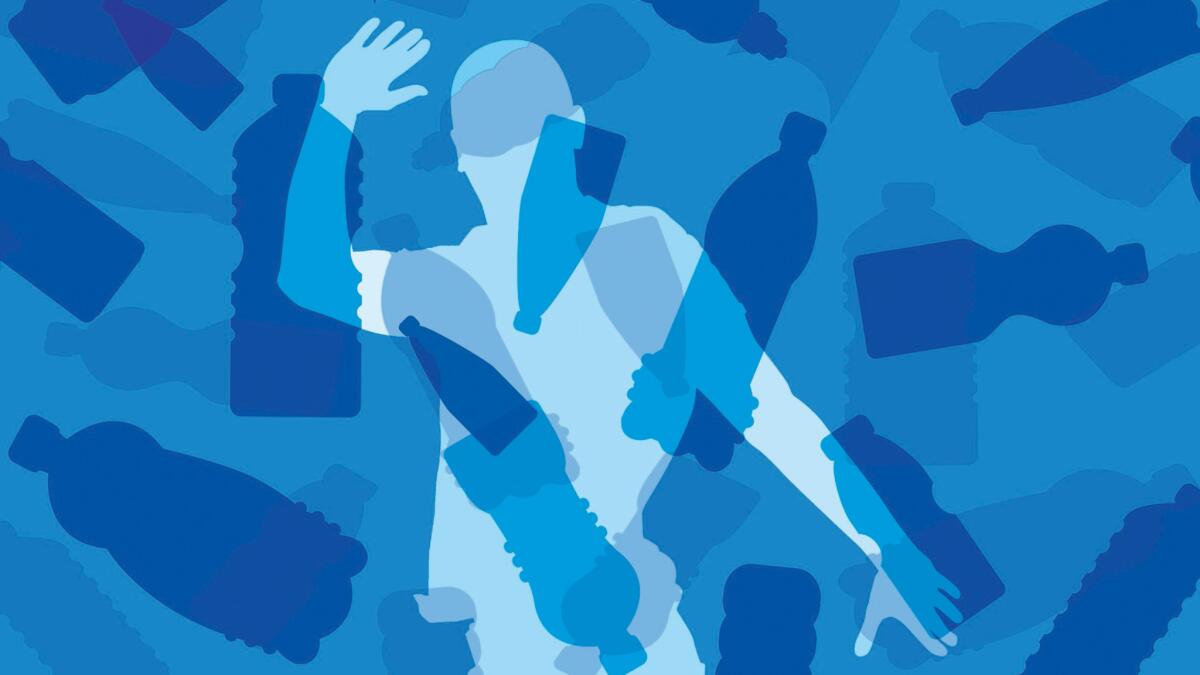Water: What you need to know about keeping hydrated

Clean, clear water: It’s the most essential of essentials. Humans need it to survive.
For two decades, we’ve been encouraged — some might say hounded — into making drinking water a habit. We carry it in plastic bottles, reusable canisters, on our backs to suck through elaborate tubing. We might even hire a doctor to have it injected into our veins.
Have we gone mad?
Clean, clear water: It’s the most essential of essentials. Humans need it to survive. Our bodies are 60% water; the brain and heart, 73%, the lungs, 83%.
WATER: Fancy bottled waters with fancy price tags | L.A.: Do you know what’s in your water?
“You need to be hydrated, and our bodies function best when [they are] in water balance,” said Boston sports nutritionist Nancy Clark, who works with the Red Sox, among others.
Your body requires water to: digest food; transport nutrients to cells so they can reproduce; grow and survive, move waste and toxins out of the body through urine; make saliva; lubricate joints and absorb shock in the brain and spine; regulate body temperature via sweat; allow the brain to produce hormones and neurotransmitters.
“You also need water for your blood,” Clark said. “If you’re dehydrated, your heart has to work three to five times harder to pump blood because it gets thicker. And you get tired.” Chronic dehydration can increase your risk of kidney stones and urinary tract infections. And even a little dehydration can make you feel, well, really bad.
“Lightheadedness, fatigue, headache, poor stamina and concentration all can result from even a small — 1% — drop in bodily fluid,” said nutritionist Elizabeth Somer, editor of the newsletter Nutrition Alert!
OK, fine. Water matters. But do we really need to carry a water bottle everywhere we go? Spend $5, even $20, on fancy bottles of H2O? And what about that saying that if you wait until you’re thirsty to drink water, it’s too late?
Do you get enough?
Let’s start with the numbers: According to Lawrence E. Armstrong, a physiologist at the Human Performance Lab at the University of Connecticut, national authorities say an adult male needs about 3 quarts of fluid each day; women need 2 quarts daily, unless pregnant or lactating, when the requirement goes up to male levels. And while some of this is met by eating food — about 20%, Armstrong said — we also need to drink liquids: water, tea, soda (of course, there are downsides to sodas) and coffee (and, no, coffee is not dehydrating, according to a 2007 study Armstrong conducted). How much water, though, is actually in dispute.
It had been conventional wisdom that eight 8-ounce glasses were needed, but in recent years kidney specialists have said a healthy adult in a temperate climate needs only half that.
The best way to tell if you are well hydrated is to check your urine: If you’re urinating every two to four hours and the color is light yellow (although vitamin supplements can affect urine color), you should be well-hydrated. “The research has found that urine color, while it isn’t a lab test, is a good indicator, and good enough to use on a daily basis,” Armstrong said. A downloadable urine color chart is at hydrationcheck.com. If you wait until you’re thirsty, it could indeed indicate a 1% drop in fluid, and by a 2% depletion, you are officially dehydrated.
Things that can dehydrate you: exercise, heat, illness (especially if accompanied by diarrhea and vomiting), alcohol, drugs and airline travel.
But are we dehydrated as a nation? No, Armstrong says.
Is bottled better?
In a word, probably not. Apart from the obvious sustainability and health issues, the problem is that while the Food and Drug Administration enforces labeling and regulates the allowable levels of contaminants in bottled water, it does not have the ability to do mandatory and widespread testing, the way the Environmental Protection Agency has over public drinking water. So with certain exceptions, meaning bottled water you know and love, you can’t tell what might be in that plastic bottle of water.
That doesn’t mean tap water is free of contaminants. “But,” said Consumer Reports director of consumer safety and sustainability Urvashi Rangan, “public water systems must be tested and must post the results. People can check on their municipal water supply by looking at the annual consumer confidence reports, which are done every year, and will give you a sense of what contaminants are in your water.” The idea is that then you can get a water filter designed to filter out those contaminants.
Frankly, the consumer confidence reports and Water Quality tables are daunting, so here’s the down and dirty, according to Rangan:
If you live in a house built before the 1970s, chances are you have lead pipes and/or pipes that are soldered with lead. And since the lead is in the pipes of your house, this won’t show up on a general report. You want to filter for lead. If you suspect lead, get your water professionally tested (preferably by a company that doesn’t also make water filters). Only use water from the cold faucet for drinking, cooking and making baby formula, and let that water run for a good 30 seconds, especially if you are on a high floor.
“There are lots of people who depend on well water, where the potential for arsenic contamination is very high,” Rangan said. And water provided by private wells is not regulated by the EPA.
If you live close to farm or industrial sites, you should get your water tested for nitrates and chemicals.
And if you live in a city, there might be pharmaceuticals in your water.
Scary, yes. But the good news is that there are water filters to address all of these issues, according to Rangan.
A carafe-type activated carbon filter is a good, affordable place to start. (“This type doesn’t solve the arsenic problem,” Rangan cautioned.)
Then there are the filters that easily screw onto your faucet, which also use carbon to filter out lead, mercury, pharmaceuticals and chlorine.
The next option is an under-the-sink water filter, which in many cases is a two- to five-stage filter, using carbon and ion-exchange technology along with reverse osmosis. Reverse osmosis filters are used for more complicated issues, including arsenic.
A glass here, a glass there: How to keep hydrated.
Here are ways to make sure you’re hydrated:
Wake up and drink a big glass of water — room temperature, cold or hot — with lemon juice, strawberries, cucumber slices, “whatever will entice you to drink,” said nutritionist Elizabeth Somer.
“Eat foods with plenty of water in them,” suggested nutritionist Nancy Clark. Yogurt, juicy fruits or vegetables, such as celery, tomatoes and cucumbers, are good choices.
Keep a water bottle in your car and close at hand on your desk. Somer goes further: “If you work at home, line up glasses on the kitchen counter and drink small amounts ... throughout the day. That way your kidneys have a chance to assimilate the fluid.”
Drink lots of water when flying, and limit your Bloody Mary consumption when you’re in the air.
If you are drinking alcohol, “for every glass of wine, drink a big glass of water,” Clark said, “and don’t quench your thirst with beer.”
MORE FROM HEALTH:
Drinking milk: the pros and cons
After shifting fads, time for a clear-eyed look at fat in our diets
Health focus shifts to gut microbiome and nurturing ‘good’ bacteria






